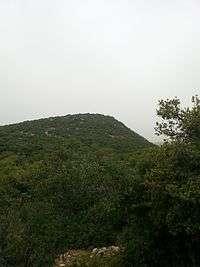Har Senaim
 | |
| Alternate name | Senaim |
|---|---|
| Region | Golan Heights |
| Coordinates | 33°16′16″N 35°43′46″E / 33.271202°N 35.729458°E |
| Type | Roman temple, Greek temple and ancient settlement |
| History | |
| Periods | Ancient Rome, Ancient Greece |
| Site notes | |
| Archaeologists | Shim'on Dar |
| Condition | Ruins |
Har Senaim or Senaim is an archaeological site that sits on a peak near Mount Hermon in the Israeli-occupied portion of the Golan Heights, 15 kilometres (9.3 mi) north east of Kiryat Shmona and 4 kilometres (2.5 mi) from Banias.[1][2]
History
The site features a Roman temple and settlement that has been included in a group of Temples of Mount Hermon.[3] The ruins of a second Ancient Greek temple were also found nearby. The Roman temple featured an altar carved with a relief of Helios, the sun god.[4] The shrine at Har Senaim was carved out of solid bedrock.[5] The settlement measures approximately 5,000 square metres (0.50 ha).[1] Various ancient Greek inscriptions were found at the site.[6][7] One inscription found on the altar called upon the great Gods in an appeal for the salvation of the Emperor Hadrian.[8] Other finds included a basalt animal muzzle and a brass ring that was decorated with the image of a merman.[9] Several coins were found dating to Byzantine and Mamluk periods. The complex at Har Senaim has been suggested to be a cult site or funerary garden and compared to the high places mentioned in the Books of Kings.[10]
References
- 1 2 Book Review of "Archaic Cyprus: A Study of the Textual and Archaeological Evidence" by A.T. Reyes, Diana Buitron-Oliver, Bulletin of the American Schools of Oriental Research, No. 303, pp. 98-100, The American Schools of Oriental Research, August 1996.
- ↑ John Joseph Collins (2001). Hellenism in the land of Israel. University of Notre Dame. ISBN 978-0-268-03051-3. Retrieved 22 September 2012.
- ↑ S. Dar & J. Mintzker., "A Roman Temple at Senaim, Mt. Hermon", Eretz-Israel, 19, pp. 30-45, Jerusalem, 1987.
- ↑ Joan E. Taylor (27 May 1993). Christians and the Holy Places: The Myth of Jewish-Christian Origins. Oxford University Press. pp. 72–. ISBN 978-0-19-814785-5. Retrieved 22 September 2012.
- ↑ Ted Kaizer (2008). The Variety of Local Religious Life in the Near East In the Hellenistic and Roman Periods. BRILL. pp. 77–. ISBN 978-90-04-16735-3. Retrieved 22 September 2012.
- ↑ S. Dar and N. Kokkinos, "The Greek Inscriptions from Senaim on Mt. Hermon", Palestine Exploration Quarterly, 124, 9-25. 35, 1992.
- ↑ Di Segni, Leah., On a dated inscription from Rakhle and the eras used on the Hermon Range, in Zeitschrift fur Papyrologie und Epigraphic 117, pp. 277-280, 1997.
- ↑ Eric M. Meyers; Mark A. Chancey (25 September 2012). Alexander to Constantine: Archaeology of the Land of the Bible. Yale University Press. pp. 255–. ISBN 978-0-300-14179-5. Retrieved 22 September 2012.
- ↑ Shimʻon Dar (1993). Settlements and cult sites on Mount Hermon, Israel: Ituraean culture in the Hellenistic and Roman periods. Tempus Reparatum. ISBN 978-0-86054-756-3. Retrieved 22 September 2012.
- ↑ Israel. Agaf ha-ʻatiḳot ṿeha-muzeʼonim; Ḥevrah la-ḥaḳirat Erets-Yiśraʼel ṿe-ʻatiḳoteha; Universiṭah ha-ʻIvrit bi-Yerushalayim. Makhon le-arkheʼologyah (1997). Israel exploration journal. Israel Exploration Society. Retrieved 22 September 2012.
Further reading
- Shim'on Dar., "The History of the Hermon Settlements", Palestine Exploration Quarterly, 120, pp. 26–44, 1988.